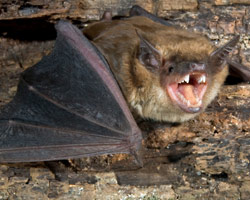Bat Removal and Control
Most Feared and Most Misunderstood. Bats are surrounded by many myths that have generated needless fear in people. Their frightening appearance, large fangs and nighttime excursions — let alone Dracula folklore — have given these flying mammals a bad rap. They do not attack people and don’t get tangled in your hair.
For the most part they are harmless, even beneficial. Their primary food source is insects, many of which can be damaging to agriculture. Controlling the insect population protects people from those pests, which can carry diseases.
 About Bats
About Bats
Brown bats are the most common bat in Pennsylvania and are a sensitive or protected species, greatly in part of the rapid spread of the white nose syndrome, which has caused high death rates in the species.
Since bats actually do have wings, they are the only mammals who can really fly. Their eyesight is poor so their “radar” system helps them navigate around and through obstacles during their swift flight. They generally roost in caves, tree hollows and other natural locations; but they can take up residence in buildings and attics during the warm weather months, and breed. They live in colonies that can grow quite large, so early detection is a key to preventing infestation. During the cold months, some bats will leave for hibernation.
They are insectivores, eating mosquitoes, moths, beetles, wasps, mayflies and gnats. Making your home their home is not only a nuisance with their scratching and squeaking noises, but also a health hazard from their droppings and urine. The smell and stains on walls and ceilings is unsightly, and the persistent odor can attract other bat colonies, even if the original is removed. Accumulation of this waste can lead to respiratory problems in humans who breathe the fungal spores that grow on the guano.
If you suspect bats are inhabiting your home, watch your roof lines, attic areas and eaves around dusk — most of their activity is 3-4 hours after dusk, and in early dawn, returning to the roost at 4-5 AM. Thorough inspection of the attic will also reveal inhabitation, by their droppings and/or roosting habits.
Bat Diseases
Bats can be carriers of a variety of viruses, including rabies (rarely), fleas and other parasites. Although rare, bats are capable of biting when threatened, so it is best never to get near a bat — rather trap it under a bucket and call a professional for help.
Professional Removal and Control of Bats
Removal of bats must always be done by a professional, both for your safety and the bat colony’s safety! Removal of bats is only allowed during certain times of the year. After the bats are removed the only real way to keep the bats out is by exclusion — that is, sealing all possible entry points to make the structure bat-proof.
Service Areas
We offer bat removal in Harrisburg, Mechanicsburg, Duncannon, Enola, Dillsburg, Carlisle, Camp Hill, New Cumberland, Lemoyne, Wormleysburg, Hershey, Marysville, Hummelstown, Steelton, Middletown, Highspire, Halifax, Dauphin and other areas within a 25 mile radius of the Harrisburg area.
We provide bat removal in Dauphin County which includes Lower Paxton Township, Middle Paxton Township, Susquehanna Township, Derry Township, Swatara Township, Lower Swatara Township, East Hanover Township, West Hanover Township, South Hanover Township, and Londonderry Township.
We provide bat removal in Cumberland County which includes East Pennsboro Township, Hampden Township, Lower Allen Township, Upper Allen Township, Middlesex Township, Silver Spring Township.
We provide bat removal in Perry County which includes Rye Township, Penn Township.
We provide bat removal in York County which includes Carrol Township, Newberry Township, Fairview Township, Monaghan Township.

 About Bats
About Bats